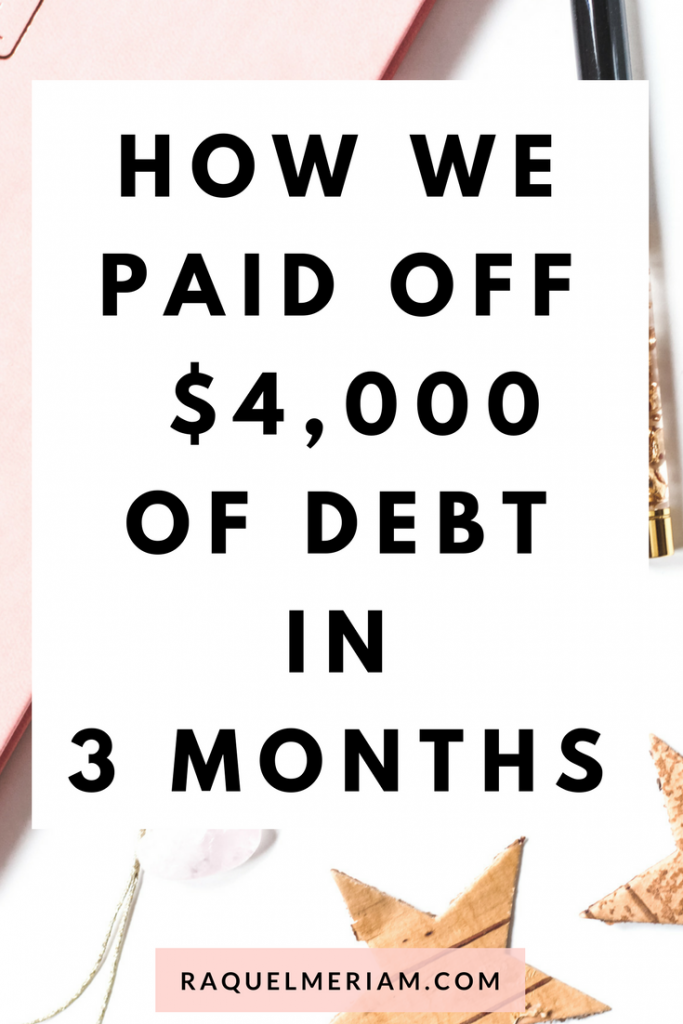
My husband and I were tired of being in debt. We wanted to tackle our debt head on but didn’t really know where to start. After doing a bit of research and reading Dave Ramsey’s book, the Complete Guide to Money, here are the steps we took to budget and work towards getting out of debt.
1) Assess your current situation
First things first, we couldn’t set a budget and plan on how to get out of debt until we knew what our current situation was.
This was probably the most difficult thing to start with because we had to face the numbers and the hard truth. We were in debt and were over spending each month.

After reviewing all our bank statements, we wrote down all our spending for the past few months. Then, we categorized everything to see how much we were spending on groceries, transportation, entertainment, clothing, gifts and miscellaneous.
It was shocking to see how much money was spent on things like entertainment, shopping and dining out. These numbers were what we needed to see to move forward with our next step.
2) Set a budget
Once we knew what we had spent in the past, we created a budget.
On our budget sheet we included our monthly income, debt owed, assets, fixed expenses, variable expenses, short-term expenses (annual fees or dues), and our long-term savings (things such as retirement savings, investments or education funds).
I created a monthly budget sheet to help us balance our budget. First we filled in everything that was a set amount which included our income, debt and assets.
We then entered our fixed expenses, which are fixed amounts that will not change month to month. Things like rent/mortgage, cell phone bills, daycare, etc…
Next we looked at our variable expenses and determined what would be a reasonable amount to spend in each category based on what we knew we were spending in the past.
Then, we wrote down all our annual expenses or what we called our short-term expenses. This included items such as membership fees, winter tires, Christmas gifts, etc… This amount was totaled up and divided by 12.
That would give us an amount we could put monthly into a short-term expenses account and when those bills were due, we could easily access that money to pay them. No surprises!
Lastly, we allocated money to our long-term savings which included our retirement savings plan, a car repair fund, a house repair fund, and an education fund for our daughter.
In the last section, we totaled everything up to make sure that our budget actually balanced. We took our income minus all our expenses above to give us the bottom line.
This number should equal zero. Every dollar should be accounted for and if it wasn’t, we would go back and revise our budget.
Where should you revise? I start with the variable expenses as that category is more flexible.
This took a little time going back and forth adjusting the budget so that it equaled zero, but we did it.
Don’t get discouraged! Each month we would revise the budget as different expenses would come up that we weren’t anticipating. Even though it wasn’t perfect, we knew that we were making progress.
3) Track your spending
Once we had our monthly budget defined we had to make sure we were going to stick with it. We had been writing our expenses down for a few months, but every week we seemed to go over budget. It wasn’t until I was given Dave Ramsey’s book the Complete Guide to Money that I really understood what we were doing wrong.
Related posts:
4) Money envelopes – the game changer!
In the first few months, we were using our debit cards to pay for most purchases.
Although we set a budget, there was no accountability to stick with that budget because we would just use our debit cards if we wanted to purchase something.
Finally, we took the plunge and started the money envelope system. This really started to move our finances to the next level.
Our debt was finally going down each month and we had money set aside to go into savings and expected expenses.
In the first three months, we paid off over $4,100 of our debt! Pretty exciting right? We have continued the momentum and after selling our house we are 100% debt free.
5) Overview
To sum things up, we took the following steps to get our finances back in order:
- Assessed our current situation – figured out what we owed
- Set a budget – income minus expenses to balance our budget to zero
- Tracked our spending – wrote down EVERY dollar we spent (even if it was just 50 cents of candy)
- Implemented the money envelope system – we paid for everything with CASH
I hope this helps you get your finances back on track. Let me know how budgeting has helped you. What worked? What didn’t? I would love to hear from you.

Please can drawa a chart of how your savings goes.
Days , months of saving money